Chapter 6 Molecular Basis of Inheritance
MOLECULAR BASIS OF INHERITANCE
DNA largest macromolecule made of helically twisted, two, antiparallel polydeoxyribonucleotide chains held together by hydrogen bonds.
➣ X-ray diffraction pattern of DNA by Rosalind Franklin showed DNA a helix.
➣ Components of DNA are
(i) deoxyribose sugar,
(ii) a phosphate, and
(iii) nitrogen containing organic bases.
(ii) a phosphate, and
(iii) nitrogen containing organic bases.
➣ DNA contains four different bases called adenine (A), guanine (G) cytosine (C), and thymine (T).
➣ These are grouped into two classes on the basis of their chemical structure:
(i) Purines (with a double ring structure) and
(ii) Pyrimidines (with a single ring structure
(ii) Pyrimidines (with a single ring structure
➣ 1953.James Watson and Francis Crick proposed three dimensional structure of DNA and won the Nobel prize.
➣ DNA double helix with sugar phosphate back bone on outside and paired bases inside.
➣ Planes of the bases perpendicular to helix axis.
➣ Each turn has ten base pairs.( 34 A0)
➣ Diameter of helix 20 A0.
➣ Two strands of DNA antiparallel.
➣ DNA found both in nucleus and cytoplasm.
➣ Extranuclear DNA found in mitochondria and chloroplasts.
➣ Two chains complementary
➣ Two chains held together by hydrogen bond.
➣ Adenine-Thymine pair has two hydrogen bonds.
➣ Guanine-Cytosine pair has three hydrogen bonds.
➣ Upon heating at temperature above 80-90 degree two strands uncoil and separate (Denaturation)
➣ On cooling two strands join together (renaturation /annealing)
➣ DNA is mostly right handed and B form.
➣ Bacterial nucleoid consists of a single circular DNA molecule .
➣ DNA double helix with sugar phosphate back bone on outside and paired bases inside.
➣ Planes of the bases perpendicular to helix axis.
➣ Each turn has ten base pairs.( 34 A0)
➣ Diameter of helix 20 A0.
➣ Two strands of DNA antiparallel.
➣ DNA found both in nucleus and cytoplasm.
➣ Extranuclear DNA found in mitochondria and chloroplasts.
➣ Two chains complementary
➣ Two chains held together by hydrogen bond.
➣ Adenine-Thymine pair has two hydrogen bonds.
➣ Guanine-Cytosine pair has three hydrogen bonds.
➣ Upon heating at temperature above 80-90 degree two strands uncoil and separate (Denaturation)
➣ On cooling two strands join together (renaturation /annealing)
➣ DNA is mostly right handed and B form.
➣ Bacterial nucleoid consists of a single circular DNA molecule .
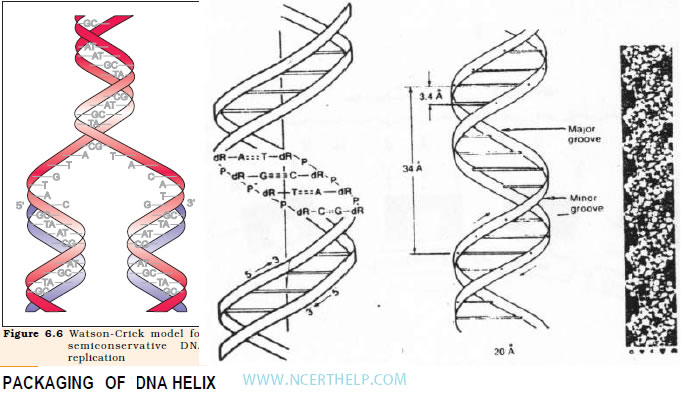
# DNA of eukaryotes is wrapped around positively charged histone proteins to form nucleosome.
# Nucleosome contains 200 base pairs of DNA helix.
# Histone octamer =2(H2a+H2b+H3+H4)
# Linker DNA bears H1 protein
# Chromatin fibres formed by repeated units of nucleosomes.
# Non histone proteins required for packaging.
# Regions of chromatin, loosely packed and stains lightly called euchromatin.
# Regions of chromatin, densely packed and stains darkly is called heterochromatin.
# Nucleosome contains 200 base pairs of DNA helix.
# Histone octamer =2(H2a+H2b+H3+H4)
# Linker DNA bears H1 protein
# Chromatin fibres formed by repeated units of nucleosomes.
# Non histone proteins required for packaging.
# Regions of chromatin, loosely packed and stains lightly called euchromatin.
# Regions of chromatin, densely packed and stains darkly is called heterochromatin.
DNA AS THE GENETIC MATERIAL
♦ Transformation experiment or Griffith effect.
• Griffith performed his experiments on Mice using Diplococcus pneumoniae.
• Two strains of bacteria are S-type and R-type cells.
• Experiments
♦Living S-strain Injected into mice →Mice killed
♦Living R-strain Injected into mice → Mice lived
♦Heat Killed S-strain Injected into mice →Mice lived
♦Living R-strain + Heat Killed S-strain Injected into mice→Mice killed
• Griffith performed his experiments on Mice using Diplococcus pneumoniae.
• Two strains of bacteria are S-type and R-type cells.
• Experiments
♦Living S-strain Injected into mice →Mice killed
♦Living R-strain Injected into mice → Mice lived
♦Heat Killed S-strain Injected into mice →Mice lived
♦Living R-strain + Heat Killed S-strain Injected into mice→Mice killed
# Griffith concluded that R type bacteria is transformed into virulent form.
# Transformation - change in the genetic constitution of an organism by picking up genes present in theremains of its relatives.
BIOCHEMICAL CHARACTERISATION OF TRANSFORMING PRINCIPLE
# Proved by Oswarld Avery, Colin Macleod, Maclyn Mc Carty
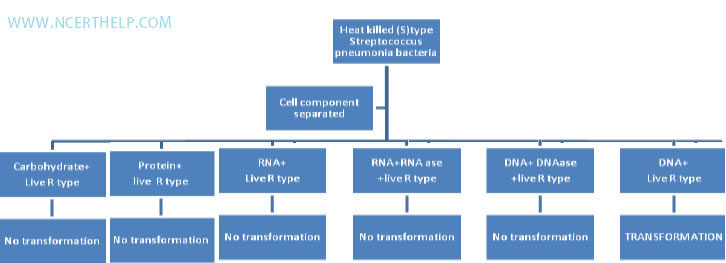
From this we conclude that DNA is the genetic material
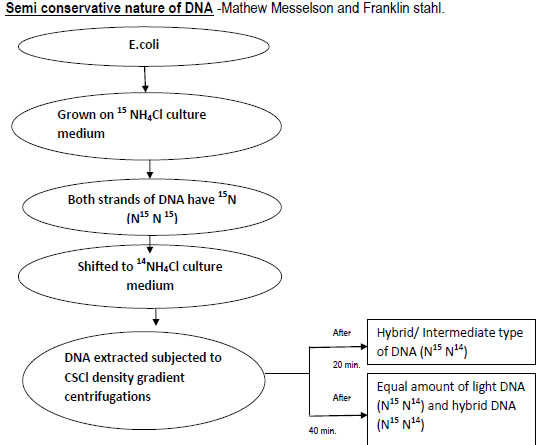
8. 3 Replication of DNA In Eukaryotes :
Definition : "Process by which DNA produces daughter DNA molecules which are exact copies of the original DNA." In eukaryotes, DNA is double stranded. The two strands are complementary to each other because of their base sequences.
Semi-conservative method of DNA replication Important points:
(i) Most common method of DNA replication.
(ii) Takes place in the nucleus where the DNA is present in the chromosomes.
(iii) Replication takes place in the S-phase (synthesis phase) of the interphase nucleus.
(iv) Deoxyribose nucleotides needed for formation of new DNA strands are present in nucleoplasm. At the time of replication, the two strands of DNA first separate. Each strand then acts as a
template for the formation of a new strand. A new strand is constructed on each old strand, and two exactly identical double stranded DNA molecules are formed. In each new DNA molecule, one strand is old (original) while the other is newly formed. Hence, Watson and Crick described this method as semi-conservative replication. (A) An overall process of DNA replication showing replication fork and formation of new strands template and lagging template
The various steps involved in this process are summarized as follows:
i. Mechanism of replication starts at a specific point of the DNA molecule, called origin.
ii. At origin, DNA strand breaks because of an incision (nick). This is made by an enzyme called incision enzyme (endonuclease).
iii. The hydrogen bonds joining the two strands are broken by the enzyme.
iv. The two strands start unwinding. This takes place with the help of a DNA unwinding enzyme Helicases.
Two polynucleotide strands are thus separated.
v. The point where the two strands separate appears like a fork or a Y-shape. This is described as a replicating
fork.
fork.
vi. A new strand is constructed on each old strand. This takes place with the help of a small RNA primer molecule which is complimentary to the DNA at that point.
vii. Each old DNA strand acts as a template (site) for the construction of new strand. The RNA primer attaches itself to the old strand and attracts the enzymes (DNA polymerase III) which add new nucleotides through base
complementation. The deoxyribose nucleotides are present in the surrounding nucleoplasm. New DNA strand is thus constructed opposite to each old strand.
complementation. The deoxyribose nucleotides are present in the surrounding nucleoplasm. New DNA strand is thus constructed opposite to each old strand.
viii. Formation of new complementary strand always begins at the 3' end of the template strand (original strand) and progresses towards the 5' end (ie in 3' - 5' direction). Since the new strand is antiparallel to the template strand, it is obvious that the new strand itself is always developed in the, 5'-3' direction. For this reason when the two original strands separate (then with respect to the origin of separation), one acts as 3'-5' template while the other acts as 5'- 3' template.
ix. Of the two, the replication of 3'-5' template begins first. Hence the new strand formed on it is called the leading strand. The other template (5'-3') must begin replication at the fork and progress back toward the
previously transcribed fragment. The new strand formed on it is called the lagging strand.
previously transcribed fragment. The new strand formed on it is called the lagging strand.
x. Replication of the lagging strand takes place in small fragments called Okazaki fragments. These are then connected together by the enzyme ligase.
xi. Replication may take place in only one direction on the DNA helix (unidirectional) or in two directions (bidirectional).
xii. At the end of the process, two double stranded DNA molecules are formed from the original DNA molecule.
Three major types of RNA:
1. Messenger RNA or mRNA- has the information to make a protein. It is very unstable and comprises ~5% of total RNA polymer. Its length is highly variable, of the range 7503000 nucleotides.
2. Transfer RNA or tRNA- small molecule, about 90 nucleotides long. It is highly folded into an elaborate 3-d structure and comprises about 15% of total RNA.
3. Ribosomal RNA or rRNA- 80% of the total RNA, is associated with subcellular structures called ribosomes in which the polymer length varies from 120-3000 nucleotides and is folded into an elaborate structure which give ribosomes their shape.
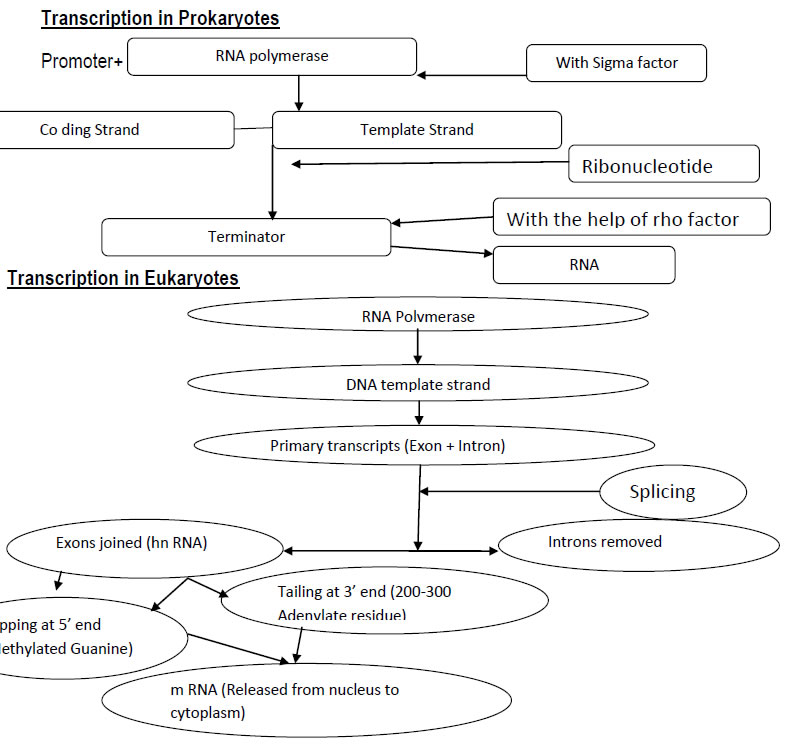

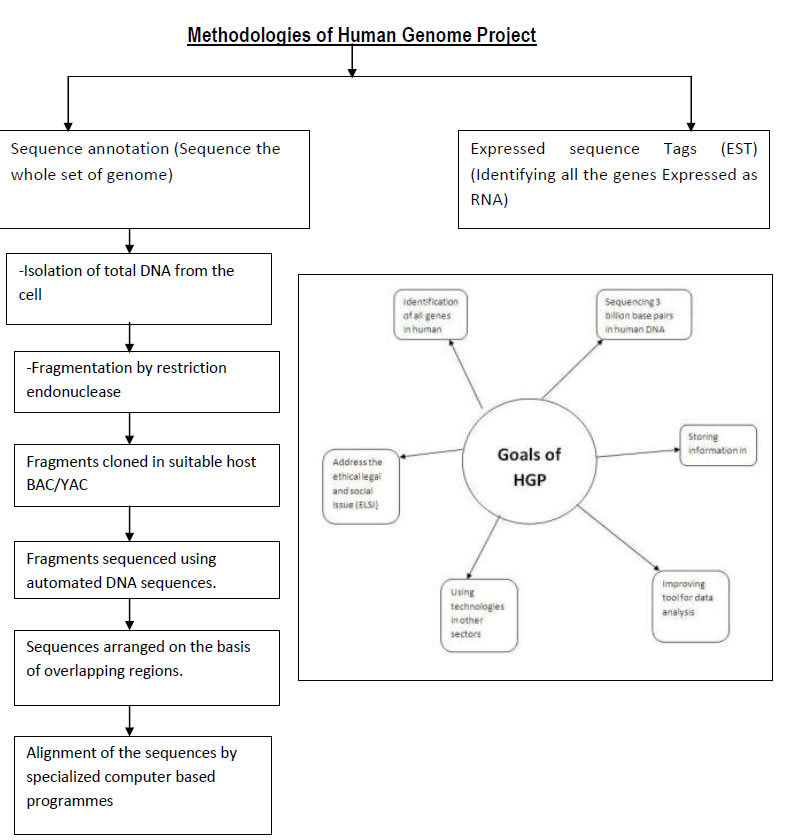
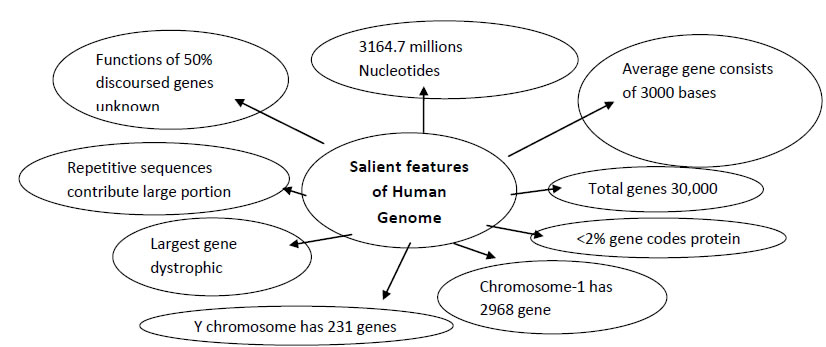
Application of Human genome project
-: Identification of defective genes.
-: Opportunity to offer early treatment.
-: Identification of genes that confer susceptibility to certain disease.
-: Prediction of protein that the genes produce.
-: Drug designing to enhance or inhibit the activities of the proteins.
-: Opportunity to offer early treatment.
-: Identification of genes that confer susceptibility to certain disease.
-: Prediction of protein that the genes produce.
-: Drug designing to enhance or inhibit the activities of the proteins.
TECHNIQUE FOR DNA FINGER PRINTING
♦ Technique developed by Dr.Alec Jeffreys.
♦ Process is also known as DNA typing/DNA profiling
♦ Process is also known as DNA typing/DNA profiling
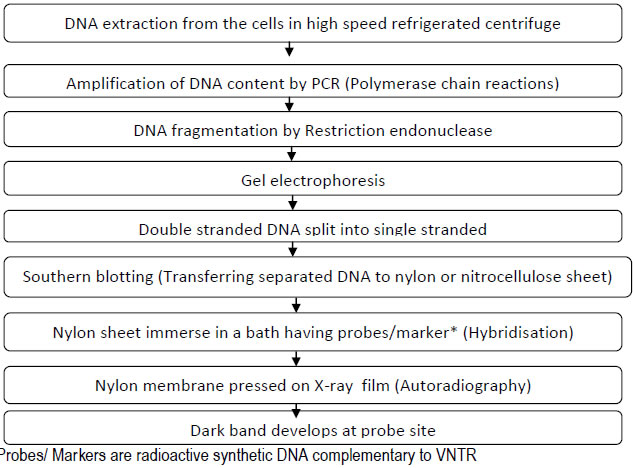
No comments:
Post a Comment